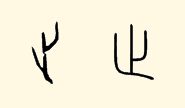 It is a bookmark sold by the Palace Museum in Taipei, from a seal on a piece titled 宋高宗書七言律詩.
It is a bookmark sold by the Palace Museum in Taipei, from a seal on a piece titled 宋高宗書七言律詩.
-
Seem like 御書( Imperial Writings) 璽寶( treasured Seal); or 御書墨寶 (Emperor 's personally written calligraphy)– Tang Ho ♦Commented Jul 7, 2018 at 7:21
-
1@drooze, you "should / would" provide an answer in details, with graphics 😼– 水巷孑蠻Commented Jul 7, 2018 at 7:32
-
@水巷孑蠻 lol maybe...it takes a bit of effort to write those answers.– dROOOzeCommented Jul 7, 2018 at 7:32
-
yes, may 10-100 times, compare to recognise at first glance.– 水巷孑蠻Commented Jul 7, 2018 at 7:40
2 Answers
The characters are 御書㞢(之)寶, which means seal of imperial writing/literature. The characters are heavily stylised in a blockish/squarish aesthetic (方篆) seen on many imperial seals.
- The explanation of the shape of「㞢」(之) is given here.
- 「寶」is easy enough to recognise for those familiar with regular script. The shape of the component「宀」is explained here.
御
「御」was originally written as
depicting a kneeling person「卩」using a pestle「午」, indicating the meaning to use/operate > to govern > imperial. Later,「彳」was added to the left and「止」was added to the bottom of「午」, leading on to the modern form「御」.
These motion-related additions may have been semantically influenced by two other words also written as「御」at one stage but now written as「迓」(yà, to welcome; semantic「辶」which is a stylised combination of「彳」and「止」) and 「馭」(also yù, to drive a carriage).
In the sample,
- 「𦈢」has been modified into the shape of「走」
「彳」has also been heavily modified from a style that looked like the left component of
「御」is thus composed from
- 「午」
- 「卩」
- 「彳」
- 「止」
午
「午」originally depicted a pestle:
The word representing this meaning is now written as「杵」. The top later became「入」:
This leads on to the seal form
Note the similarity of the top part to「土」. Straightening the stroke out, as required with the 方篆 style, leads onto the form seen in the sample.
卩
「卩」originally depicted a kneeling person, which directly leads on to the form seen in the sample:
彳
「彳」is reduced from「行」, which is a picture of an intersection:
「彳」is subject to wild stylising, and the form in the sample is no different.
止
「止」was originally a simplified depiction of a foot:
The word representing this meaning is now written「趾」. The change to seal script looks like
書
「書」is comprised of
「聿」, a semantic component;
「者」, a phonetic component. In the modern form, this has been reduced to「曰」, but seal scripts and earlier still retain「者」, as with the sample posted in the question. The appearance of「者」in seals is briefly alluded to here.
Note that the character is not「畫」.「畫」(originally to draw boundaries between fields > draw) definitely needs to contain「田」(fields) as a component, unless the character sample egregiously demonstrates corruption.
「聿」originally depicted a hand「⺕」(variant of「又」) holding a brush:
Merging the two together leads on to seal forms which look like
-
1very good (^ o ^) though it's in doubt any "foreigners" can understand it :) maybe even, average chinese users.– 水巷孑蠻Commented Aug 5, 2018 at 8:29
it's 御書之寶
read from top right:
御 (u+5fa1)
http://humanum.arts.cuhk.edu.hk/Lexis/lexi-mf/search.php?word=御
bottom right:
書 (u+66f8)
http://humanum.arts.cuhk.edu.hk/Lexis/lexi-mf/search.php?word=書
there's very slight chance that, this one might be
畫 (u+756b)
http://humanum.arts.cuhk.edu.hk/Lexis/lexi-mf/search.php?word=畫
top left:
之 (u+4e4b)
http://humanum.arts.cuhk.edu.hk/Lexis/lexi-mf/search.php?word=之
bottom left:
寶 (u+5bf6)
http://humanum.arts.cuhk.edu.hk/Lexis/lexi-mf/search.php?word=寶
together it means:
the treasure (寶) of (之) his majestic (御) writing (書)
edited.
i found this one in internet, the original seal of 御書之寶:
then, the webpage of this "inspired" souvenir:
http://www.npmshops.com/main/modules/MySpace/PrdInfo.php?sn=npmshops&pc=1510000119274
this version has rounded 90° corner, strictly horizontal & vertical lines; and simplified ornament. well, i prefer the ancient copper one :)














